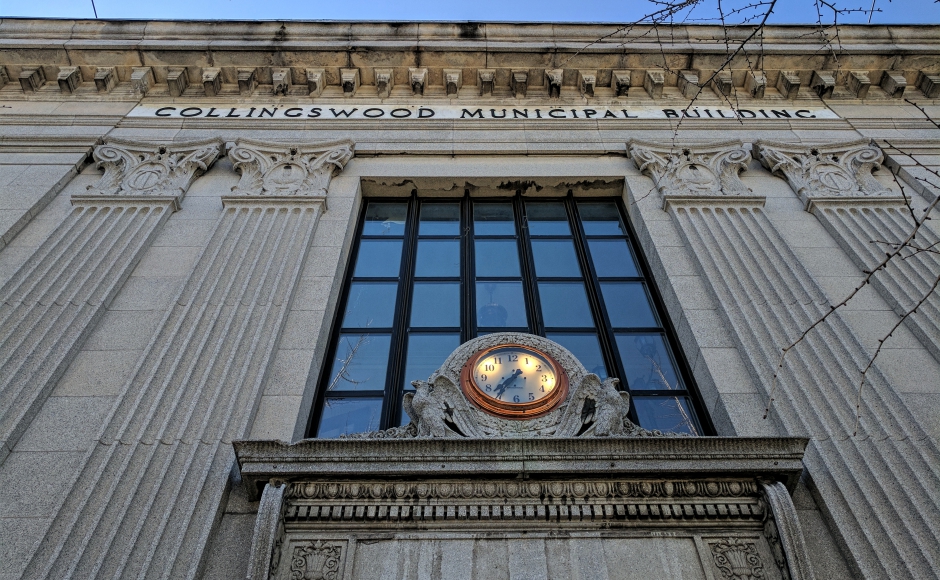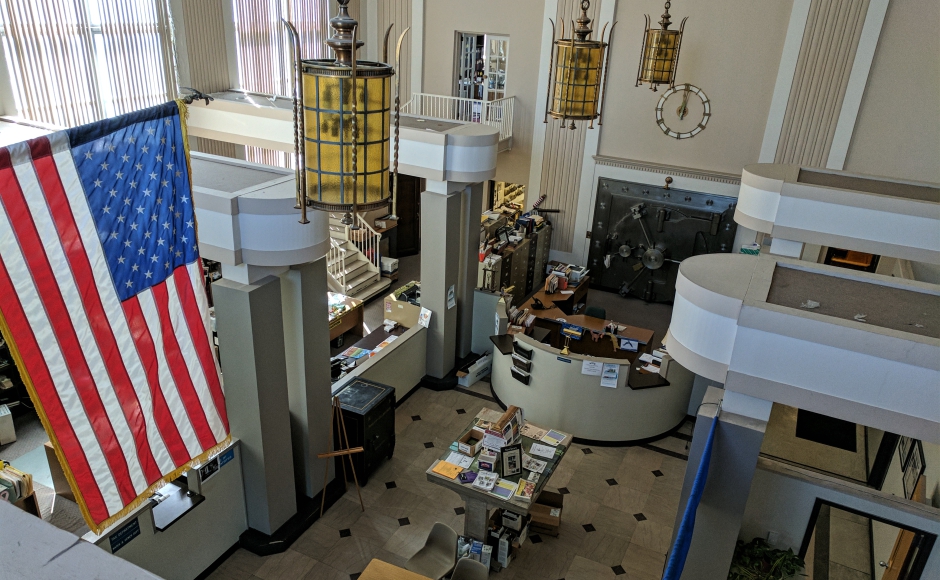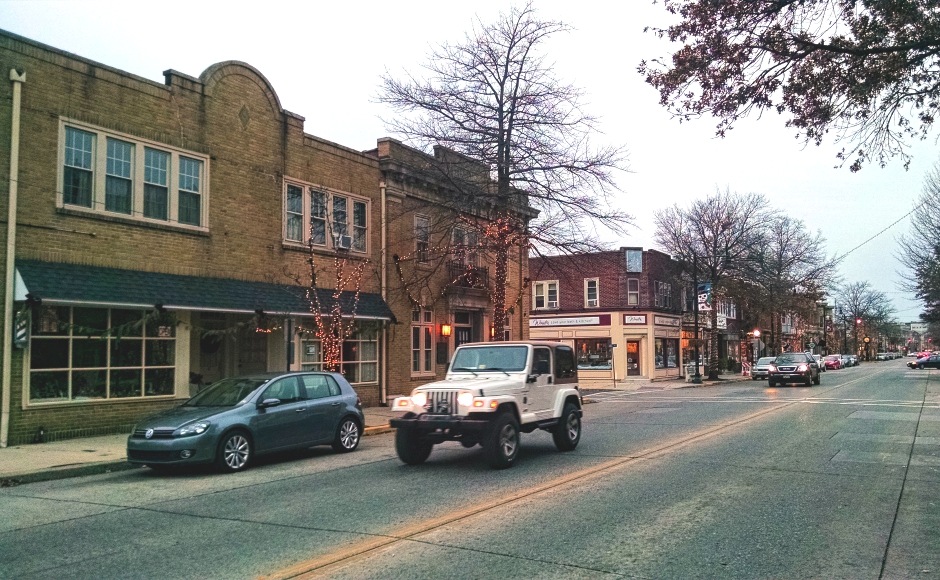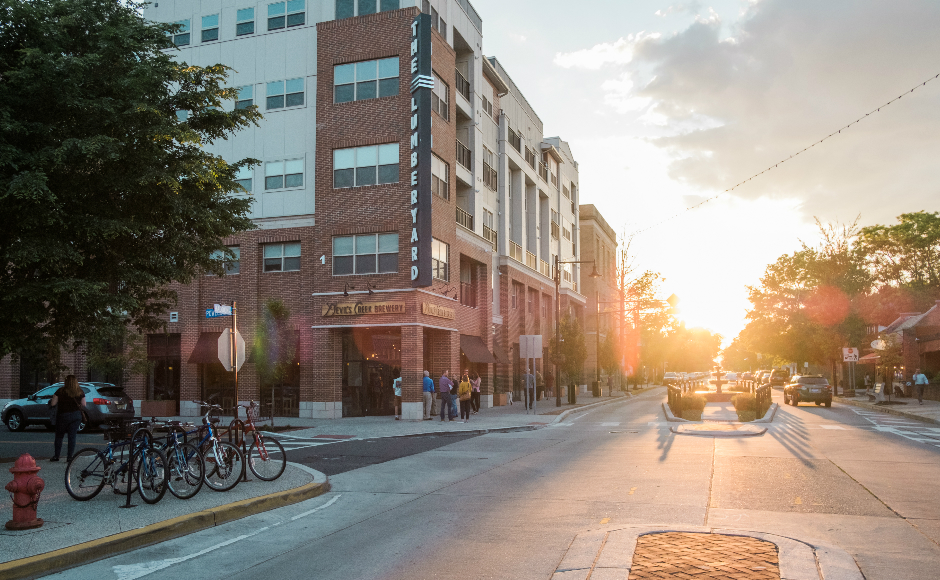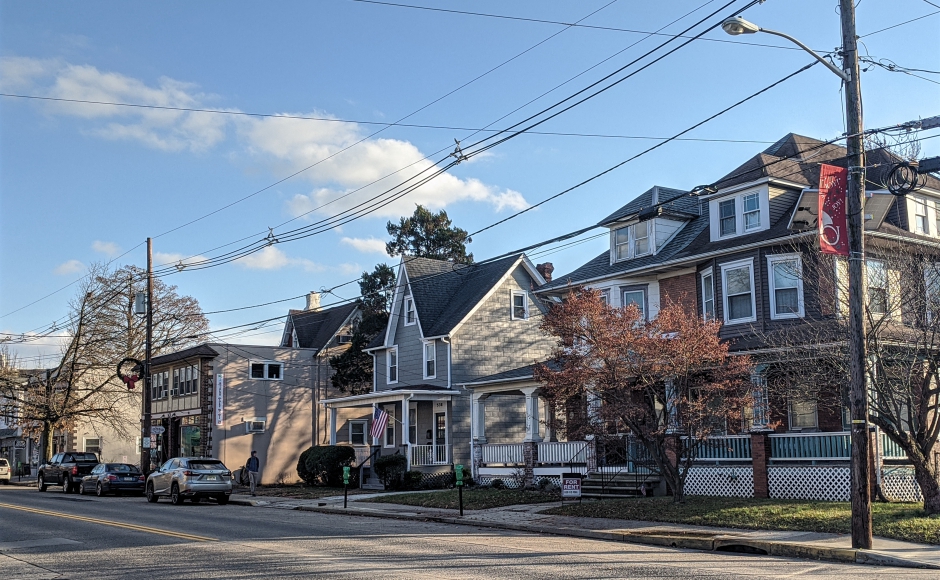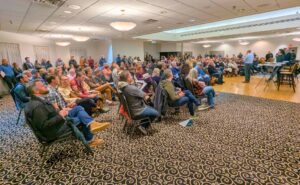The goals and objectives originate in feedback from the borough Planning Board. It’s the first update to the guiding document since 2008.
By Matt Skoufalos | December 11, 2019
Once every decade, New Jersey municipalities are required by state statute to produce a comprehensive review of their Master Plans.
These guiding documents establish goals and recommendations that provide a reference point for what’s to come.
Local governments aren’t obligated to undertake any specific actions by adopting these updates, but they do provide an indication of existing challenges and priorities.
In Collingswood, the latest, recently drafted update offers a glimpse of the future direction of the borough.
Among its goals are: preserving the architectural character of borough neighborhoods, redefining the borders of the business district, and even cutting back on the reasons that applicants would be required to appear before the borough planning board itself.
The current Collingswood Master Plan was last updated in 2008. This year’s re-examination marks the second time the local government is revisiting that original document since it was adopted in 1999. Recommendations mentioned in the document have bubbled up from the experiences of board members, borough professional staff, and elected officials in the time since the last update, said Collingswood Mayor Jim Maley.
“After we do the re-exam, we’d then look to see if there’s any specific zoning ordinances that we would put in place to help achieve those goals,” Maley said.
Here are some of the key changes outlined in the revised document, which is scheduled to be taken up by the borough Planning Board at its December 16 meeting.
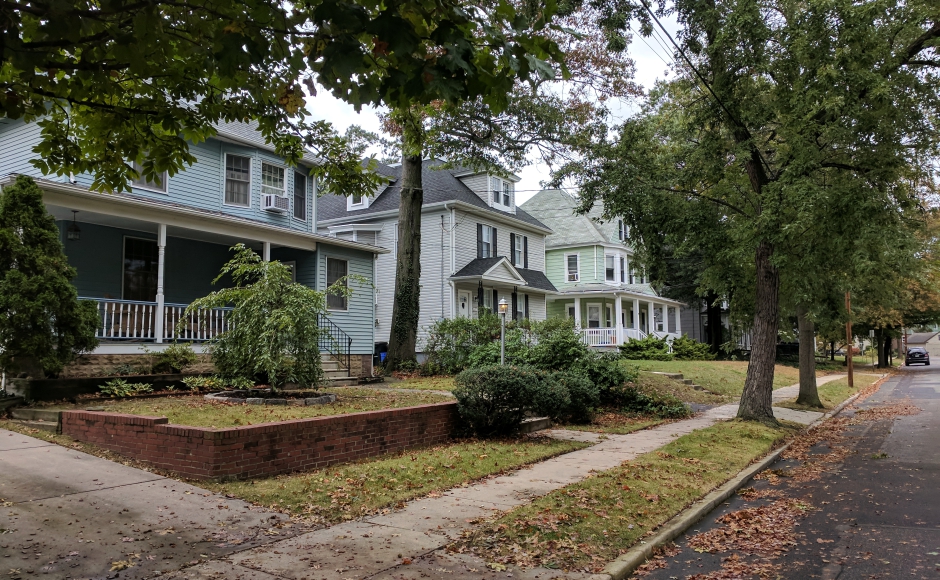
Homes on East Stiles Avenue comprise rental and single-family properties and residents of a mix of ages. Credit: Matt Skoufalos.
“Maintain and enhance the existing character of residential neighborhoods through the preservation of existing housing typologies.”
“Each residential neighborhood in Collingswood has a distinct aesthetic and character,” the report notes.
“Under current residential zoning standards, there is little incentive, outside of the historic preservation districts, for new construction or redevelopment to conform to the existing neighborhood character.”
Those efforts to maintain the integrity of neighborhood character—preserving a consistent scale and architecture in context with what’s already there—reflect a town-wide effort to maintain a diversity of housing inventory, including smaller, more affordable properties.
“One of the things I think we love about Collingswood is you can buy the starter house, starter apartment, right up through the home you raise your family in, and downsize after that,” Maley said.
“We’re trying to avoid what’s going on in Haddonfield and Haddon Township, where people are getting one lot or two lots, tearing down four-squares, and building a mansion,” he said.
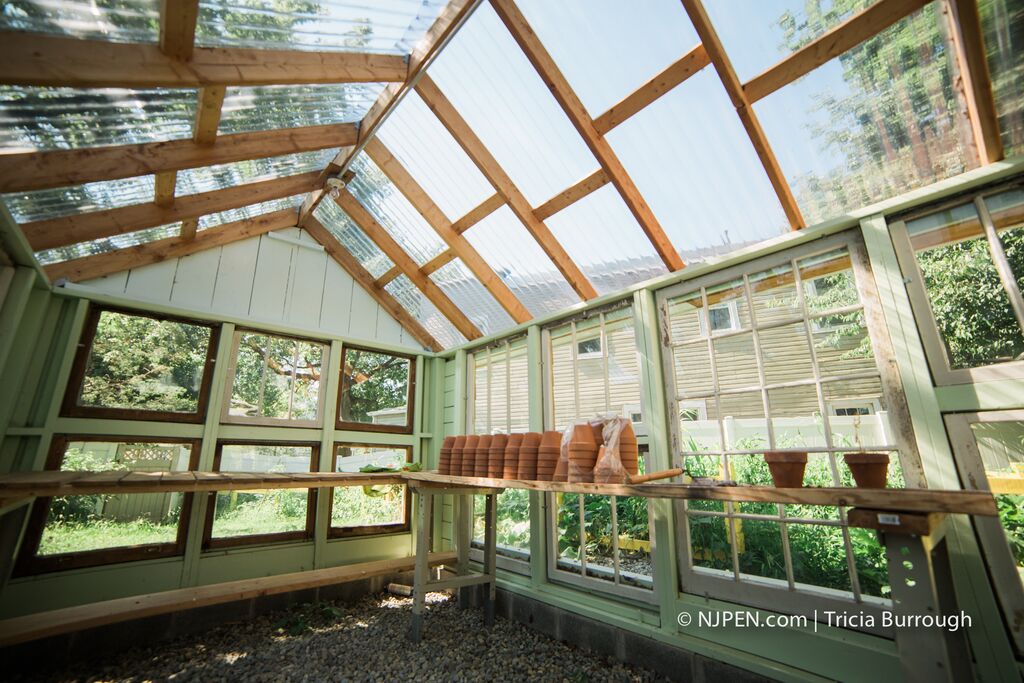
Interior, Bruce Faulseit’s greenhouse in the Collingswood Community Garden. Credit: Tricia Burrough.
Complete Streets, Green Buildings, Environmental Sustainability
The borough government already resolved to establish and adopt such policies as part of a package of sustainability ordinances introduced this fall; these objectives are further contained within the master plan update.
Complete Streets is a theory of transportation planning and construction that aims to make roadways accessible and safe for users of all abilities and ages via various modes of transportation.
Green building guidelines follow evolving regulations for renewable energy and the prioritization of environmentally friendly building materials.
Specific mention is made of requiring “green stormwater infrastructure,” like dry wells, vegetated swales, and rain barrels. Porous paving and concrete surfaces, which absorb stormwater, wouldn’t count against pervious coverage requirements.
Sustainability goals include those connected to grants provided by the Sustainable Jersey program; among them, the borough will work to create public charging stations for electric vehicles while also working to protect and preserve the sustainability of its historic resources.
Redefine limits of the central business district (CBD), extend the professional office district (POD), add more opportunities for parking.
One of the most significant master plan revisions involves redefining the limits of the borough CBD as those blocks of Haddon Avenue between Fern and Harvard Avenues.
These tighter restrictions would push back on the “urban sprawl” that has arisen from the mixture of residential, commercial, and vacant properties along stretches of the highest-trafficked roads in the town, the report notes.
The present design “has created gaps in the continuity of street-level active storefronts” and makes the downtown less walkable, it said. The report also notes that the same issue—single-family homes sprinkled in among other non-residential uses—is a persistent challenge “along major thoroughfares like Collings Ave., Haddon Ave., the White Horse Pike, and Route 130.
“The land use conflicts between residences and businesses continue to pose safety problems and environmental nuisances for the residents along these busy streets,” the report notes.
By contrast, extending the opportunity for those properties to be used as professional offices could generate a better mix of foot traffic in the borough downtown and mitigate the difficulties posed by homes butting up against businesses.
“Given what’s going on in the world with retail, we have to give some consideration to tightening up the first-floor, retail-only districts,” Maley said. “Pulling them in some will help us maintain a retail core while allowing the outer areas to be open to professional and other commercial uses on the first floor. Some of the blocks that aren’t in the core really struggle to maintain [operations].”
The master plan also notes that the borough could use additional opportunities for parking, especially given the additional planned capacity for more intense commercial and business uses in the CBD.

Tattoo artist Jeff Miller tried to open a shop in Collingswood but failed to acquire a supermajority vote to overcome local zoning law prohibiting it. Credit: Matt Skoufalos.
Address unregulated uses including, but not limited to: tattoo shops, medical marijuana facilities, arcades, and short-term residential rentals.
One of the most frequent criticisms of the borough business climate is its list of prohibited uses.
Under Chapter 141 of the Collingswood municipal code, they include: ice or roller skating rinks, movie houses, massage or tattoo parlors, bowling alleys, pool halls, flea markets, discos and nightclubs, accessory apartments, boarding homes, and community residential homes.
The prohibition on tattoo parlors cost artist Jeff Miller a chance to open his business in the borough downtown, despite having won a majority approval from the borough planning board. The prohibition (at the time) of breweries was a factor in Tonewood Brewing not opening up in Collingswood, and that business headed to Oaklyn.
With recreational marijuana headed for a 2020 ballot question, Collingswood doesn’t want to miss out on a chance at new business, the mayor said.
“I get the criticism it’s been like that for a long time,” Maley said. “With cannabis, there is something coming down the pike with deregulation. [We want to] zone or regulate it in a way that you don’t lose that opportunity, because if you structure it the right way, it can be a big revenue producer.”
Reassess limited breweries in the borough business district.
As written, Collingswood code permits “limited breweries” in the CBD, which covers manufacturing facilities capable of producing up to 300,000 barrels annually.
The updated recommendation suggests that “consideration should be given to allowing a restricted brewery” in the borough business district.
Restricted breweries—or brewpubs—are limited by volume to 10,000 barrels annually, but are also allowed to operate in conjunction with an adjoining restaurant.
Maley said the objective is meant mainly to certify that the borough brewery regulations are aligned with those at the state level. Borough Administrator Keith Hastings was quick to note that Collingswood may be slower to act on this recommendation for fear of compromising the makeup of its BYOB restaurant industry.
“We’re not going to give any one restaurant an unfair advantage over the others,” Hastings said.
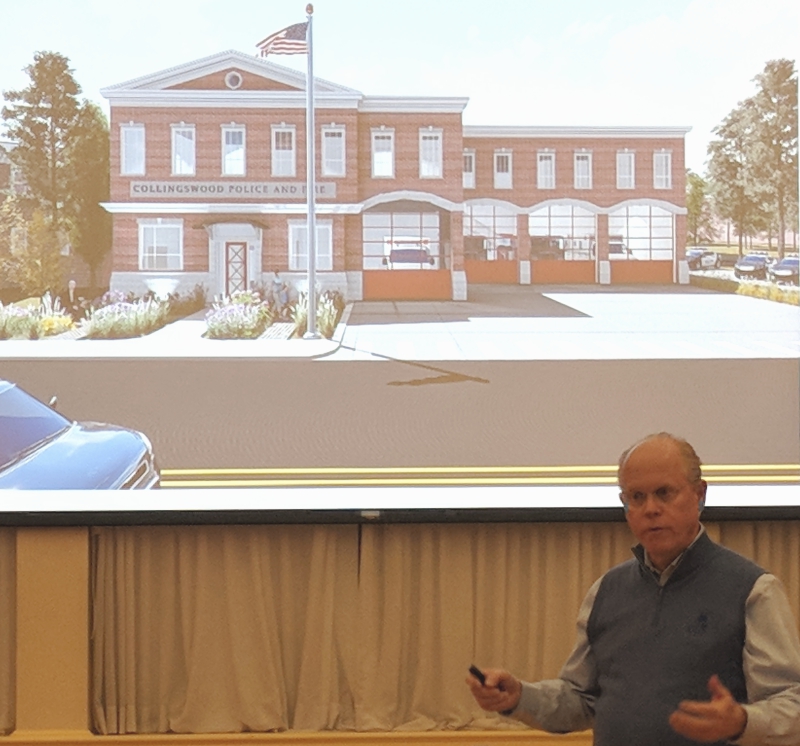
Jim Maley introduces designs for the new Collingswood public safety building. Credit: Matt Skoufalos.
Eliminate instances where “inconsequential changes “require a hearing before the Planning Board.
Much of existing borough zoning law is written around Standard Industrial Classification (SIC) codes, which group business types by their products, services, and delivery systems.
Adherence to those codes has occasionally meant that small businesses coming into Collingswood have had to make costly and time-consuming appearances before the borough planning board when their models might already be compliant with code.
“We’re doing what we can to clean it up as quick as we can,” Maley said. “Virtually every town’s switched away from [SIC]. It’s really coming up with what the appropriate requirements are.”
By the same token, the master plan update advises that the borough adjust its bulk requirements for small lots in single-family residential zones “so that applications for minor improvements and accessory structures, such as small decks and sheds, no longer require variances.
“Minimum side and rear yard setbacks in these districts should be critically examined and adjusted where appropriate so as to reduce the need for variances without adversely impacting neighboring properties,” the report notes.
The report also recommends that the local government update the definitions in its code to “confirm that the purpose of the ordinance is being satisfied.
“A definition should be provided for all verbiage which might otherwise leave room for interpretation,” it reads, citing the example of loosely written code that broadly prohibits “fast food restaurants” in the CBD, but which could undercut “establishments which are clearly not fast food restaurants.”
“We’re probably not going to encourage a McDonald’s to open in the downtown, but the words are going to include some businesses that aren’t McDonald’s, and that’s what we’re going to be grappling with to fix that,” Maley said.
The report also invites officials to “consolidate design standards for signs” for the same reasons.
Considering areas for redevelopment.
The master plan notes that the whole of Collingswood is considered an area in need of rehabilitation, a byproduct of rebating residents from the sale of the Parkview Apartments in the late 1990s with the understanding that they’d reinvest the refund into their property upkeep.
But it highlights certain areas as possible targets for redevelopment, including the block of Haddon Avenue between West Madison Avenue and West Knight, as well as West Madison Avenue itself; and the area of the Bible Presbyterian Church at the corner of Cuthbert Boulevard and Haddon Avenue.
As to sites that could be considered for redevelopment, this report notes “the stagnant and unproductive conditions of land located along Haddon Avenue (Block 97, Lots 1-13.03).”
Redeveloping those areas would remain in keeping with creating greater consistency of uses in the borough CBD and POD, “and thereby aid in restoration of the site to a more fully productive condition,” the report notes.
There are no active plans to redevelop either site.

